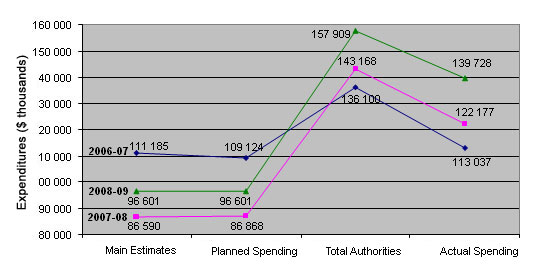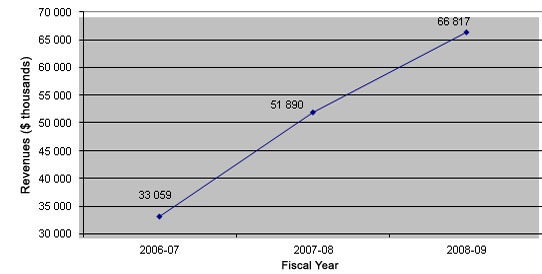Common menu bar links
Breadcrumb Trail
ARCHIVED - Canada School of Public Service
 This page has been archived.
This page has been archived.
Archived Content
Information identified as archived on the Web is for reference, research or recordkeeping purposes. It has not been altered or updated after the date of archiving. Web pages that are archived on the Web are not subject to the Government of Canada Web Standards. As per the Communications Policy of the Government of Canada, you can request alternate formats on the "Contact Us" page.
Minister's Message

I am pleased to present the Departmental Performance Report for the Canada School of Public Service (Canada School) for 2008-09.
The Canada School promotes leadership, accountability and excellence in the Public Service. With its integrated approach to the training and development needs of public servants, it contributes to building a highly-skilled, well-trained and professional public service workforce that delivers results for Canadians.
During the 2008-09 fiscal year, the Canada School participated in the horizontal strategic review of central human resources organizations. Through this process, it identified ways to be more efficient and effective, allowing it to fully align its programs with department and agency learning needs and to support deputy ministers in their accountability for learning in their organizations.
The Canada School continues to offer a unified approach to lifelong learning. Playing an integral role in the renewal of the public service, it ensures that public servants at all levels and in all parts of the country have access to the knowledge and skills they need to deliver results for Canadians, both now and in the future.
The Honourable Vic Toews, P.C, Q.C, M.P
President of the Treasury Board
Section I � Departmental Overview
Summary Information
Raison d��tre
The federal public service is an organization with a distinct purpose and unique jobs, values and measures of success. Public servants require training that is tailored to successfully meeting their fundamental objective of making an important difference to Canadians. The Canada School of Public Service (Canada School) is a common learning service provider for the Government of Canada. It brings a unified approach to serving the common learning and developmental needs of public servants and helps ensure that all public service employees across Canada have the knowledge and skills they need to effectively deliver results for Canadians, now and in the future.
Responsibilities
Established in 2004, the Canada School is responsible for ensuring that public servants have the necessary skills and knowledge to perform effectively in their current jobs and to take on the challenges of future jobs. It provides a wide range of learning activities across the country to build individual and organizational capacity and management excellence within the public service. Key messages related to government priorities, such as Public Service Renewal, are disseminated by incorporating elements of these priorities into training programs. The Canada School is responsible for offering courses that foster a common understanding of public service values and ethics among public servants.
Source: Prime Minister's Advisory Committee on the Public Service, Third Annual Report to the Prime Minister, Achieving Results: Accountability and Action, February 2009.
The Treasury Board's Policy on Learning, Training and Development highlights the value of learning and the importance of creating a learning culture within the public service. It establishes employee, organization and employer learning responsibilities and outlines the employer's specific training requirements. The Canada School's identified program priorities are geared to help deliver on the Policy's expected results.
The Canada School was created under the Public Service Modernization Act, combining three organizations that previously provided public service-wide learning, training and development: Language Training Canada, Training and Development Canada, and the Canadian Centre for Management Development. The Canada School is part of the Treasury Board of Canada portfolio and operates under the authority of the Canada School of Public Service Act (CSPS Act).
A Board of Governors is responsible for the conduct and management of the affairs of the Canada School. This Board has a prominent role in the Canada School's governance structure and is integral in its planning, reporting and strategic decision-making processes.
The CSPS Act provides for the following authorities and flexibilities to enhance year-over-year stability and operational consistency in support of achieving the mandate of the Canada School:
- Revenue Respending Authority (CSPS Act, subsection 18(2))
Subject to any conditions imposed by the Treasury Board, the revenue from fees received by the School in a fiscal year through the conduct of its operations may be spent by the School for its purposes in that, or the next, fiscal year.
- Appointment of the President (CSPS Act, subsection 13(1) and section 14)
Subsection 13(1): The Governor in Council shall, after consultation by the Minister with the Board, appoint an officer, to be called the President of the School, to hold office for a term not exceeding five years, and the President has the rank and status of a deputy minister.
Section 14: On the expiration of any term of office, the President is eligible to be reappointed for a further term.
- Staffing Authority (CSPS Act, subsection 15(2))
� the President may, on behalf of the School, appoint and employ teaching and research staff and may, with the approval of the Treasury Board, establish the terms and conditions of their employment, including their remuneration.
- Intellectual Property Management Authority (CSPS Act, subsection 18(1)(b)) The Board may, with
the approval of the Treasury Board, prescribe the fees or the manner of determining the fees � to be charged by the
School when selling, licensing the use of or otherwise making available any copyright, trade-mark or other similar property
right held, controlled or administered by the School.
Strategic Outcome and Program Activity Architecture
The chart below illustrates the Canada School of Public Service's complete framework of program activities, sub-activities and sub-sub-activities, which roll-up and contribute to progress in achieving the Strategic Outcome.

Summary of Performance
| Planned Spending | Total Authorities1 | Actual Spending |
|---|---|---|
| 96,601 | 157,909 | 139,728 |
| Planned | Actual | Difference |
|---|---|---|
| 940 | 881 | 59 |
| Program Activity |
2007-08 Actual Spending |
2008-092 | Alignment to Government of Canada Outcomes | |||
|---|---|---|---|---|---|---|
| Main Estimates |
Planned Spending |
Total Authorities |
Actual Spending |
|||
| Foundational Learning | 86,040 | 68,829 | 68,829 | 113,545 | 99,091 |  Government Affairs Government Affairs |
| Organizational Leadership Development | 17,056 | 13,133 | 13,133 | 21,207 | 20,382 |  Government Affairs Government Affairs |
| Public Sector Management Innovation | 19,081 | 14,640 | 14,640 | 23,157 | 20,255 |  Government Affairs Government Affairs |
| Total | 122,177 | 96,602 | 96,602 | 157,909 | 139,728 | |
| Less Respendable revenue3 | (52,543) | (32,000) | (32,000) | (66,329) | (71,085) | |
| Plus: Cost of services received without charge | 13,149 | -- | 14,103 | -- | 14,800 | |
| Total Departmental Spending | 82,783 | 64,602 | 78,705 | 91,580 | 83,443 | |
Risk Analysis
Learning is an essential element in the renewal of the public service. It affects the federal government's ability to recruit and retain the talent required to provide quality services to Canada and Canadians.
In 2008-09, the Canada School implemented a Risk Management Policy and Framework and launched a comprehensive update of its Corporate Risk Profile. Key risk areas were identified, including curriculum planning and design, the management of registrations, information technology management, and workforce management, all of which were perceived to be relatively important corporate risks. Mitigation actions continued to be implemented on an ongoing basis.
The Canada School continued to invest in designing and offering a full suite of learning products and services in support of Public Service Renewal priorities. A formalized department-wide curriculum review process was implemented and linked to the business planning cycle. Blended learning, including e-learning methods, continued to be implemented to maximize the effectiveness of delivery methods and use of learners' time.
With respect to the management of registrations, the four legacy systems that were in place when the Canada School was created are reaching the end of their life cycle and require replacement in order to ensure the ongoing system reliability, data integrity and timeliness of information. To address this situation, the Canada School updated its registration portal, developed an integrated database for registrations and, subsequent to final Treasury Board approval and vendor selection, began work to implement an ILMS. It is expected that the ILMS will provide better reporting capability, increase operational efficiency and facilitate the exchange of information with departments and agencies.
Information technology management is critical for the successful implementation of the ILMS and for supporting ongoing operations. The Canada School operates in a shared service environment with established service level agreements. There is ongoing dialogue with the shared service provider in relation to organizational requirements and for monitoring the existing service level agreement. The Canada School had decentralized information technology functions since its formation in 2004, however there has since been a concerted effort to regroup these functions organizationally in order to have better overall support for information technology priorities.
Workforce management continued to present challenges in 2008-09. The Canada School has continued to evolve and mature in recent years and this has led to periods of change within the workforce. Adjustments have been made to support strategic priorities and to meet the demand for learning products and services, as well as to align learning activities with government priorities. The nature of the Canada School's business requires a specialized skill-set in adult education together with a deep knowledge of the government context, a combination not always easy to find.
Initiatives were launched to support managers in their efforts to recruit employees with the required competencies on a timely basis and motivate them to stay with the organization. In 2008-09, staffing plans were developed and collective staffing processes were undertaken. Learning plans were developed considering career development for employees, thereby contributing to recruitment efforts, employee motivation, the development of competencies and skills, improved retention and succession planning. In addition, exit interviews were completed with departing employees to understand causes of turnover, internal surveys on workplace well-being were conducted to identify issues of direct concern and interest to employees, and the Working Group on Workplace Well-Being was established for discussing employee issues and proposing corrective action.
Expenditure Profile4

Revenue Trend5

| Vote # or Statutory Item (S)6 | Truncated Vote or Statutory Wording |
2006-07 Actual Spending7 |
2007-08 Actual Spending7 |
2008-09 Main Estimates |
2008-09 Actual Spending8 |
|---|---|---|---|---|---|
| 40 | Operating expenditures | 77,310 | 59,643 | 58,154 | 57,962 |
| 40 | Grants and contributions | 316 | 375 | 375 | 375 |
| (S) | Contributions to employee benefit plans | 8,642 | 9,613 | 6,072 | 10,304 |
| (S) | Spending of revenues pursuant to Subsection 18(2) of the Canada School of Public Service Act | 26,750 | 52,543 | 32,000 | 71,085 |
| (S) | Spending of proceeds from the disposal of surplus crown assets | 19 | 3 | - | 2 |
| Total | 113,037 | 122,177 | 96,601 | 139,728 | |
